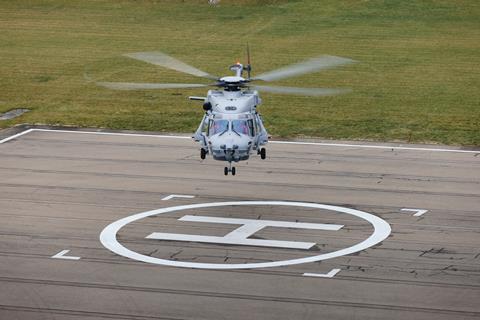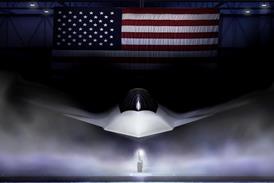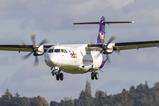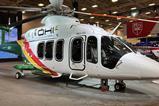NH Industries (NHI) is confident that it can meet the tight delivery schedules laid down by its German navy customer for the new NH90 Sea Tiger to allow the retirement in 2026 of the service’s fleet of elderly Westland Sea Lynx helicopters without creating a capability gap.
Germany placed a 31-unit order for the Sea Tiger – a new anti-submarine and anti-surface warfare (ASW/ASuW) variant of the naval NH90 – in late 2020 and deliveries are due to commence in late 2025, running until 2030.
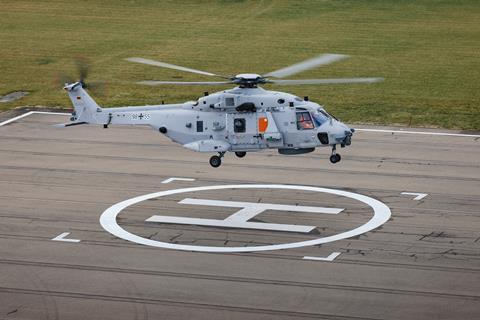
Speaking at an event in Donauworth on 30 November to mark the Sea Tiger’s maiden sortie – a milestone that took place earlier in the month – Axel Aloccio, president of the NHI consortium, insisted that the programme is on track.
“The first delivery is two years from now. We were on time for the first flight and we will be on time for the first delivery.”
Naval Captain Broder Nielsen, commander of German naval aviation, says the arrival of the Sea Tiger “will be a huge milestone” for the service “because we are operating with really ageing aircraft”.
Due to the increase of Russian submarine activity on the back of the war in Ukraine, the prompt delivery of the Sea Tiger is vital to keep open “endangered sea lanes of communication”.
“We have to be able to find and track those submerged vessels, that is why we are pushing enormously to get this weapons system – the earlier the better.”
Nielsen says the navy’s ambition is to “embark [the Sea Tiger] as soon as possible” following delivery, which “at the earliest” would be 2027 – a timeline he describes as “really sporty”.
“There is an operational need for these aircraft and I have to push this forward as fast as I can. I am pretty hard and putting a lot of pressure on the crews, but I know that if we do not we will not succeed.”

Axel Hoffmann, NH90 project manager at Germany’s BAAINBw federal procurement agency, says the progress to date is the “result of a successful collaboration” between all the parties involved.
“We will grow out technical capabilities over the next 18 months. The Sea Tiger needs to undergo a very challenging flight-test programme – several campaigns are planned following a navy-specific programme.”
Aloccio foresees “lots of flights over the next 12-14 months to test the system” which will take place in both Germany and France; qualification of the helicopter will take around 10 months, he estimates.
Airbus Helicopters, a partner in the NH90 consortium alongside Leonardo Helicopters and GKN/Fokker, is building the Sea Tiger at its final assembly line in Donauworth near Munich.
To be equipped with a dipping sonar and sonobouy dispenser, the Sea Tiger will also be capable of carrying up to four EuroTorp MU90 torpedoes or MBDA MARTE ER anti-ship missiles. It will also feature the latest mission system, new electro-optical sensors, and an updated electronic support measures suite.
And Michael Kohlhaas, general manager for NATO helicopter contracting body NAHEMA, says other NH90 operators “view the Sea Tiger as being a target configuration” for potential future upgrades.
Germany already has experience with a separate variant of the naval NH90, having earlier this year taken delivery of its last of 18 Sea Lion helicopters as a replacement for its 50-year-old Westland Sea Kings for search and rescue (SAR) and utility missions.
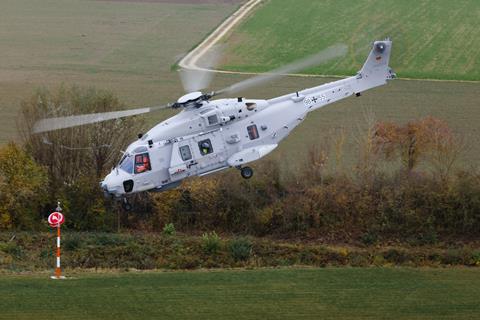
However, the introduction of the Sea Lion was not plain sailing. Despite a 2016 maiden sortie followed by first delivery two years later, full operational capability status was only achieved earlier this year and the last Sea King will not retire until August 2024.
Nielsen insists lessons have been learned and the switch to the new type will be simpler, not least due to the commonality between the two NH90 variants.
“Nobody had flown in a Sea Lion when it came in. Since then we have built up vast experience; we have a couple of very experienced crews and that will make the transition to the Sea Tiger a lot easier than the kick-off on the Sea Lion.”
Crew training has yet to begin, although an initial group of operators has been embedded with the Dutch navy, an existing NH90 operator, to gain experience of the helicopter’s ASW capabilities.
One complicating factor is the need to continue embarked operations with the Sea Lynx right up until its retirement in 2026 and then “switch off pretty rapidly”.
“But that is a kind of trade off. We will not accept a capability gap,” says Nielsen.
Common complaints from NH90 operators relate to the helicopter’s high maintenance burden and lower than promised availability rates, issues the manufacturer is belatedly addressing.
But Nielsen says the German navy has not encountered problems with the serviceability of its Sea Lion fleet, noting that any availability challenges are due to a shortage of crews.
“We are in phase where we cannot keep up with the transition training of our crews – very often we have more aircraft available than our crews can fly.”
One slight complication with the Sea Tiger’s introduction is that it is larger than the Sea Lynx helicopter it replaces and therefore cannot be accommodated on the navy’s smallest frigates, the F123 Brandenburg-class ships.
Nieslen says unmanned assets will instead be deployed from these vessels. Germany in 2021 contracted ESG Elektroniksystem for the supply of three Sea Falcon systems – based on the UMS Skeldar V-200 platform – to be operated from its corvette fleet “and we will have to look at how that is evolving”, he says.
However, in the longer term, the navy will require a larger system capable of carrying sonobouys and torpedoes in support of the Sea Tigers and incoming Boeing P-8A Poseidon maritime patrol aircraft, eight of which are on order.
